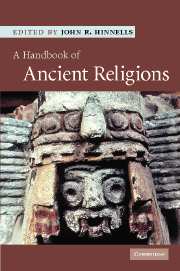Book contents
- Frontmatter
- Contents
- List of illustrations
- List of maps
- List of tables
- List of contributors
- Introduction
- 1 Palaeolithic art and religion
- 2 Ancient Egypt
- 3 Religion in ancient Ugarit
- 4 Mesopotamia
- 5 Ancient Israel to the fall of the Second Temple
- 6 Greek religion
- 7 Religions in the Roman Empire
- 8 Ancient Europe
- 9 The Indus Civilization
- 10 The religion of ancient China
- 11 Aztec and Inca civilizations
- Index
- References
5 - Ancient Israel to the fall of the Second Temple
- Frontmatter
- Contents
- List of illustrations
- List of maps
- List of tables
- List of contributors
- Introduction
- 1 Palaeolithic art and religion
- 2 Ancient Egypt
- 3 Religion in ancient Ugarit
- 4 Mesopotamia
- 5 Ancient Israel to the fall of the Second Temple
- 6 Greek religion
- 7 Religions in the Roman Empire
- 8 Ancient Europe
- 9 The Indus Civilization
- 10 The religion of ancient China
- 11 Aztec and Inca civilizations
- Index
- References
Summary
Historical and methodological perspectives
Introduction
The major source for information about the religion of ancient Israel is the Hebrew Bible, referring to twenty-four books written in Hebrew from roughly the ninth to the second century BCE and accepted as Holy Scripture by Jews. Additional information comes from books not found in the Hebrew Bible, but included in the Greek Septuagint (a translation of the Hebrew Bible and other texts, begun in the third century BCE), such as the books of Maccabees. An important contribution is also made by the findings of archaeology, including the Dead Sea Scrolls.
That scholars possess an extensive literature by way of original sources for ancient Israel's religion is, at first sight, an advantage. On further inspection it turns out to be a disadvantage, for the following reason. For much of recent western history the Bible has been regarded as an infallible source of information for the origin of the universe and the earliest history of the human race, not to mention the religion of ancient Israel. In parts of the world where biblical criticism has not touched new and younger churches, the Bible is still regarded in this way. If the Bible is believed to be infallible, the task of describing ancient Israel's religion becomes simple. For the period covered by the Bible all that is needed is for its contents to be outlined with modern readers in mind.
- Type
- Chapter
- Information
- A Handbook of Ancient Religions , pp. 214 - 265Publisher: Cambridge University PressPrint publication year: 2007



